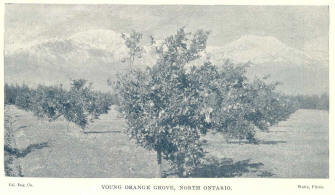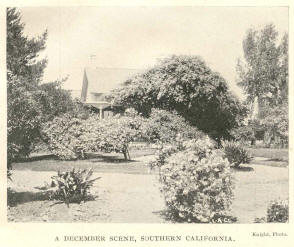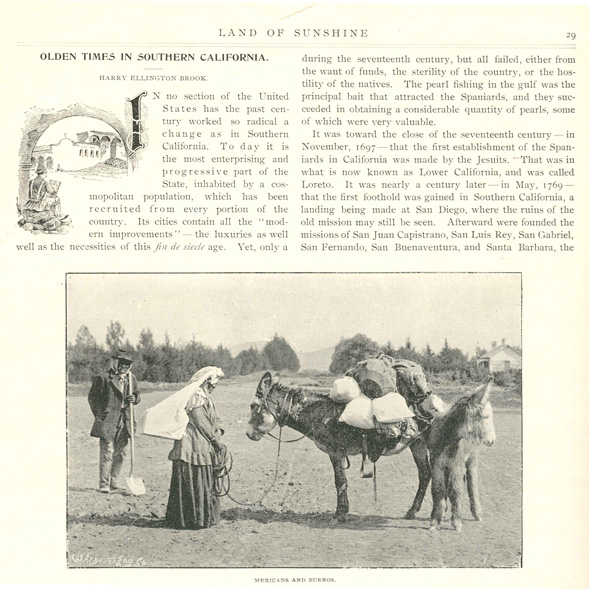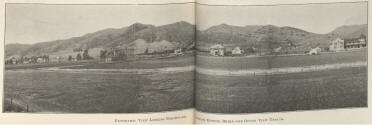|

|
Table
of Contents
Explorations
of the West
Sam
Dalsheimer
Caitlin
Goss
Nick
Schradle
David Sena
Representations
of
Native Americans
Richard
Dybas
Amanda Leong
Cynthia
Robertson
The
Western Railroads
Ronni Toledo
Kayt
Fitzmorris
Jon Ingram
David
Halperin
The
California
Gold Rush
Jordan Helle
Adam
Lawrence
Marisa
Pulcrano
Patrick Ryan
California
as Western Destination/
Mediterranean Boosterism
Maddy Kiefer
Danielle
Mantooth
Molly
Nelson
Stefanie Ramsay
Other Online
Exhibits
|
Introduction
Beginning in
the late nineteenth century,
boosters marketed Southern
California to residents of other
states, purporting it to be a land
of permanent vacation. Americans
from the Midwest and the East were
encouraged first to visit the
wonderful land of California, and
then eventually make permanent
residence there. Charles F. Lummis
edited two magazines that
beautifully illustrate the ethos
of the culture of boosterism.[more]
Land
of Sunshine and Out West
provided ready-made examples
of the good life in California.
Particularly interesting is the
postcard provided by Land of
Sunshine that could be sent
to friends and families back home
along with a subscription to the
magazine. Lummis urged newly
transplanted Californians to
spread the message of boosterism
to their Eastern friends by
saying, “You have not forgotten
them – the people you grew up with
back in Ohio, or New York… they
often speak of you and say, ‘He is
out in Southern California now,
making money hand over fist. Lucky
fellow! I wish I were there.’”
(13) Such blatant promotion is
rampant in these magazines. The
focus of this strategy was
centered around several themes.
These include quality of climate,
abundance of agriculture,
romanticization of California’s
mission history, and the real
estate boom of Hollywood. The
following essays discuss these
aspects of California boosterism
in more depth.
Lummis, Charles F. Land of
Sunshine. Land of Sunshine
Publishing Co., June
1894: 13.
|
|

Land of Sunshine,
article: “The Orange in
Southern California” –
Volume II, No. 4, March
1894

- Maddy
Kiefer
Horace
Edwards’ article, “The
Orange in Southern
California,” boasts the
extreme success of the
orange in the Golden State,
attempting to prove to the
rest of the country that
this seemingly insignificant
attribute was reason enough
to relocate to California.
He explains that
“Orange-growing is
undoubtedly the most
important horticultural
industry in Southern
California,” and describes
it as the “undisputed king”
of the agriculture industry
(Edwards, 67). He appeals to
easterners by insisting
that, “To those brought up
in the bleak and wintry
East, orange-growing has
always a deep fascination,”
and that they find no
greater joy than when they
have the chance to visit a
California orange grove
(Edwards, 67). Easterners
frequently express a desire
“to pick an orange from the
tree ‘with their own
hands,’” as there is no
other fruit with “such a
halo of romance” (Edwards,
67).
When reading advertisements
in Land of Sunshine, it is
apparent that the various
ads were generated to appeal
to different demographics,
each of them presenting
varying aspects of the
culture and opportunities
that California provided.
The agricultural aspect,
seen in this article, is
appealing to many Midwestern
farmers, reassuring them
that they could continue
their farming work even out
west, and romanticizing the
experience of having an
orange grove. In contrast,
other ads and articles boost
the civilization and
metropolis that can be found
in California.
However, many of these
advertisements are
misleading. This article
fails to mention
California’s largely
engineered environment, and
only briefly points out that
oranges, despite not being
native to the state, can
only grow there because of
the engineering of the land
(Edwards, 67). It also
doesn’t mention the
remoteness of Los Angeles
from the rest of American
civilization – once
Midwesterners would move
that far west, they would
seldom be able to go back
home, and they would be in a
large region that had few
developed cities.
Horace Edwards briefly
mentions the lack of
accessible water in Southern
California, which is often
omitted from other ads, and
discusses the commitment
necessary to be a successful
orange grower. Oranges need
moisture to thrive, which
can only be supplied by
irrigation. Therefore, it is
important for farmers to
recognize this initial money
and energy. Although this
may seem like an
inconvenience, it is
actually a blessing in
disguise (according to
Edwards). One needs to be
entirely committed to caring
for the groves, so it is not
a job to be taken up
lightly. Orange groves can
only be successful “where
the greatest care had been
taken in cultivating,
picking, packing and
shipping” (Edwards, 68).
Although Edwards mentions
these necessary qualities,
he only mentions it in a
positive light. He doesn’t
describe the extent to which
one must be committed, such
as the labor, equipment,
wealth, and patience that
are required. He also fails
to admit that only a handful
of orange growers can be
successful; there was not an
extraordinarily large amount
of demand for oranges at
this time. When examining
articles, such as this one,
it becomes obvious that
magazines like Land of
Sunshine were attempting to
appeal to many different
demographics, and therefore
tended to omit many crucial
qualities of true California
living.
Edwards, Horace. “The Orange
in Southern California.”
Land of Sunshine, March
1894, 67-68.
Return to Top
|
|

Land of
Sunshine, article: “Some
Characteristics of the
Southern California
Climate” - Volume II, No.
1, Dec. 1894

- Danielle
Mantooth
"Mediterraneanism
and the Southern California
Climate"
One of the ways in which
Southern California was
marketed to residents of the
Eastern and Mid-Western
states was in terms of its
climate. Essential to this
promotion was the concept of
Mediterraneanism.
Mediterraneanism asserted
that Southern California
would grow into a society of
importance because of its
climate. Just as Rome and
Athens had become
influential centers, so
would Southern California,
simply because they shared
the same climatic
characteristics. Thus, the
particular weather of
Southern California became a
central focus of boosterism
for the state.
The magazine Land of
Sunshine made blatant and
copious references to the
sublime climate of
California. A photograph on
the cover of the December
1894 edition shows a winter
landscape in California.
Instead of snowdrifts,
rosebushes in bloom and
sunshine are featured. This
photo represents the broader
thesis of Southern
California boosterism.
Americans from other states
should travel to California
in search of a welcome
respite from the brutal
winters they have
experienced elsewhere, and
eventually make a permanent
move to this land of eternal
sun. Further discussion of
the merits of the
Mediterranean climate can be
found in an article written
for the magazine in 1894 by
Horace Edwards entitled
“Some characteristics of the
Southern California
Climate.” Edwards wrote that
the region “possesses a
distinctive climate,
considered by Southern
Californians a trifle
superior to any other on
earth” (42). Moreover, in
the area, “an average of 325
days in the year are
cloudless” (42). Remarks
such as these are meant to
entice the weary easterner
to Southern California by
pointing out the fact that
the weather is hardly ever
inclement, let alone snowy.
However, if anyone should
get the wrong impression,
Edwards claimed that “the
idea of Southern California
as an arid region is as
erroneous as the other idea
that we are flooded with
water during half the year
and dried up during the
other half” (43). This, of
course, is exactly the case,
but knowledge of this
situation would not have
convinced many to move to
the region. Edwards also
assures prospective
Californians from the
Mid-West that there is an
“absence of severe storms of
every description. Cyclones
and tornadoes…are here
entirely unknown” (43).
The entire purpose of Land
of Sunshine was to spread
the word about this new
Mediterranean paradise.
Southern California was
promoted as a sort of
“garden of eden” where
migrants could leave their
overcrowded, frigid cities
behind and find their own
place in the sun. When
Mediterraneanism is
considered, these jaded
transplants from the east
could be part of a “high
civilization” upon their
arrival. The underlying
principle being that since
Southern California shares
the same Mediterranean
climate with Greece and
Rome, that it too would grow
into an advanced society. In
reality, the climate of
Southern California may
leave much to be desired.
The fact that Edwards needed
to refute rumors about the
“aridity” of the region
suggests that the “garden”
aspect of this “garden of
eden” had been manufactured
and ardently cultivated.
Nonetheless, the climate of
Southern California
accounted for a large part
of boosterism in the late
nineteenth and early
twentieth century, as many
Americans travelled west in
search of paradise.
Return
to Top
|
|

Land of
Sunshine, article:
"Olden
Times in Southern
California" - Volume I,
No. 3, August 1894

- Molly Nelson
Romanticization of
California’s Mission History
California boosters
harnessed the power of
California’s Spanish mission
history to contribute to
their image of California as
a land of beauty, plenty,
and most importantly,
leisure. According to the
1894 Land of Sunshine
article “Olden Times in
Southern California,” the
modern, “cosmopolitan,”
“enterprising and
progressive” Southern
California of 1894 still
retains the “easy-going
Spanish habit of putting
everything off until la
manana… a custom to which
the newly arrived gringo
readily accustomed himself”
(Lummis, 29). The California
boosters used a romanticized
vision of the agriculture,
real estate, and climate of
the Spanish missions and
their Native American
inhabitants to make
California as attractive as
possible to tourists and
potential residents.
Land of Sunshine takes care
to emphasize the calm,
idyllic aspects of Spanish
mission life, particularly
those elements which have
continued into the present.
Descriptions of agriculture
hide the reality of the
back-breaking, strictly
scheduled labor Indians
performed in the missions,
as described by Kent
Lightfoot in his book
Indians, Missionaries, and
Merchants (60). Instead, it
takes the form of “small
orchards and vineyards”
cultivated by the priests
and livestock “raised by the
aid of the converted
Indians” (Lummis, 29). This
quaint imagery does,
however, include essential
components of California
farming to which newcomers
to the region would be
attracted: orchards of nuts
and fruit and the production
of wine as well as meat and
dairy. The article’s
descriptions of Spanish
ownership and development of
land are also clearly aimed
towards potential buyers.
The lives of the rancheros,
the large landowners,
“constituted the height of
happiness,” with “A horse to
ride, plenty to eat, and
cigaritas to smoke… What
more could the heart of man
desire?” (Lummis, 31).
Similarly, the “one-story
adobe architecture” of the
period “formed a fitting
background to the easy-going
habits of the
pleasure-loving residents”
(Lummis, 29). This suggests
to potential real estate
buyers that they too could
experience the independent,
leisurely lifestyle of a
ranchero and suggests the
attitude they should have
towards purchasing and
developing land. The mild
Southern California climate
is also used as a selling
point for the past, when
life was “lived carelessly
and uneventfully, in the
land of sunshine, in those
early days” (Lummis, 31).
While the “accursed thirst
for gold” may have sped up
the pace of modern life, the
sun still shines on
California and this
effortless living is still
possible (Lummis, 31). By
selling California’s
enchanting Spanish history,
the boosters are also
selling the California of
the present.
This strongly romanticized
presentation of mission
history contributes to the
postcolonial Orientalist
discourse about the
subjugated Native American
population, “who found the
padres hard task-masters and
often longed for the earlier
days of unrestrained
liberty, before the white
man set foot on Alta
California” (Lummis, 29).
This article incorporates
romantic or positive
stigmatization as described
by Edward Said in his famous
work, Orientalism. This
attitude of positive
stigmatization is applied
not only to the domination
of the Spanish over the
Native Americans, but is
also used to discuss a
second level of domination –
that of the conquering
United States over the
Spanish colonizers
themselves. The descriptions
of the simple, “picturesque”
existence of the padres and
rancheros are also a form of
romantic stigmatization
(Lummis, 29). The California
boosters promote admiration
of the Spanish “other” for
their quaint, carefree
lifestyle in contrast to the
sophisticated “great
American commonwealth”
founded by the “adventurous
spirits” of western migrants
(Lummis, 31). This attitude
simultaneously celebrates
the perceived simplicity of
the past while establishing
modern-day Californian
civilization as superior.
Lightfoot, Kent G. Indians,
Missionaries, and Merchants:
The
Legacy of Colonial
Encounters on the California
Frontiers. Berkeley:
University of California
Press, 2006.
Lummis, Charles F. "Olden
Times in Southern
California." Land
of Sunshine, August 1894
Said, Edward W..
Orientalism. New York:
Vintage, 1979.
Return
to Top
|
|

Out West article:
“Hollywood, the
City of Homes” - Volume 21, No.
1, July 1904

- Stefanie Ramsay
In
the early 20th Century,
California was marketed as a
perfect home for both
families and for those
looking for a new
cosmopolitan lifestyle. The
hope of advertisers was that
people who visited
California would make the
move permanent. One article
describing real estate in
Hollywood, “Hollywood, the
City of Homes”, exemplifies
the ways in homes and the
city were marketed to
prospective residents. While
the article may have been
convincing in its romantic
descriptions of Hollywood,
the truth of this city was
that it was not the center
of high culture yet and the
advertisements embellished
many facts of Hollywood. The
highly mythologized
presentation of real estate
in California gave emigrants
false hope of a new and
exciting lifestyle out west.
However, it was this myth
that led to the construction
of a glamorous Hollywood.
The homes in Hollywood in
1904, when this article was
published, are built in
various styles with the hope
that they would appeal to
wide range of people. In
fact, according to this
article, there is “not a
shabby home in town” (98).
There are homes built in
Mission style as well as
European style homes that
are built to show the
sophistication of the city.
Every home is described as
“rising from the Cahuenga
Valley…[with a] view of the
breakers at the Playa del
Ray” and located by the
Santa Monica Mountains (98).
Not only will a prospective
resident be intrigued by the
style of houses, but by the
beautiful location as well.
Above all, new residents
could feel “the velvety
softness of the air” and
smell that “the whole place
is filled with the perfume
of flowers” (97). Hollywood
was marketed to seem like a
vacation, but a permanent
one.
Thought it was marketed as
the perfect place to start a
new life, Hollywood was not
yet a bustling city of the
elite class, as is made
clear in the photographs
that accompany this article.
The photographed homes do
not appear to be unique but
seem fairly ordinary, with
no immaculate views of the
ocean or mountains, but
rather, set in surprisingly
desolate areas. This is a
startling contradiction in
marketing and highlights the
way in which romantic
language was utilized in
order to present a false
notion of Hollywood.
However, the myth of this
exciting city reflected the
hopes that Hollywood had for
its future and ultimately
produced the city that it is
today. People were attracted
to the city because of some
false advertising but then
built it to be the city that
they had dreamed about. This
can be seen in the promotion
of real estate. For example,
“homes have dancing parlors
and all have capacity for
quite elaborate functions”
(110), so that people could
entertain their guests in a
luxurious manner before the
city built venues to fulfill
that need. The reputation of
Hollywood as a city of
glamour started with the
false belief that it was
this way from the beginning,
but this myth was needed in
order to ultimately attain
that standing.
Lummis, Charles F.
“Hollywood, the City of
Homes.” Out West (1904):
97-111.
Return to Top
|
|
About
this Project / Acknowledgements
Occidental
College's "American Frontier"
Research Seminar was developed by
Dr. Jeremiah B.C. Axelrod, Adjunct
Assistant Professor of History.
The library project
is developed in collaboration with
the Special Collections
Department:
Dale Ann Stieber, Special
Collections Librarian
with student staff
Henry Boule and Claire Lem and
Laila Tootoonchi and Anahid
Yahjian.
Title Image:
Thomas Moran, "Nearing Camp,
Evening on the Upper Colorado
River, Wyoming, 1882," from
http://www.boltonmuseums.org.uk/collections/art/paintings_prints_and_drawings/oil/nearing_camp_moran
|
|
Page last edited on 03/12/2013.
Occidental
College Library Special
Collections & College Archives
© 2009 Occidental College
|
|
|
|
|